The photographs that tell the full story of the Rohingya refugee crisis
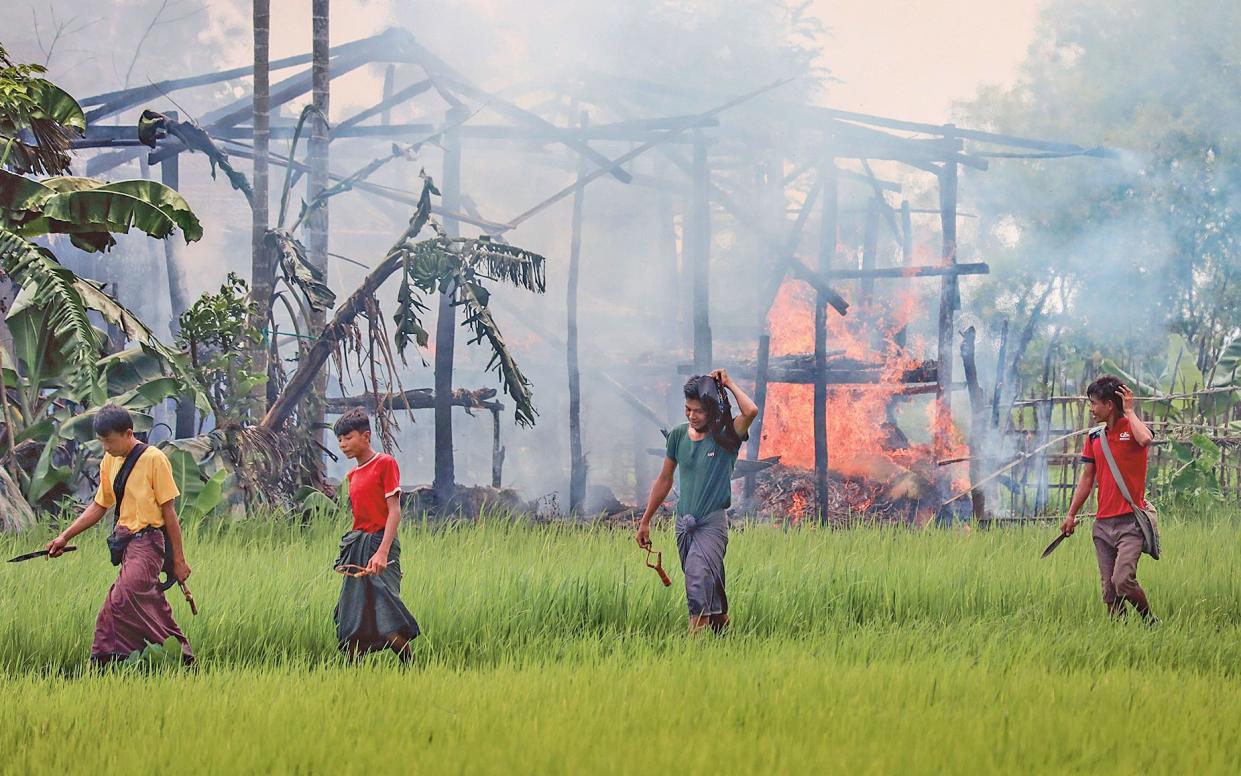
They arrive ill and exhausted, having walked for days through jungle, rice paddies and mountains, or having braved dangerous sea and river voyages in ramshackle boats. Some of them are newborn, others in their 80s. Not everyone survives the journey. All that do are desperate.
Since 25 August, nearly 450,000 refugees have crossed from Burma (also known as Myanmar) into neighbouring Bangladesh, after long-running tensions between Rohingya Muslims and the predominantly Buddhist Burmese population erupted into violence in the remote western state of Rakhine.
By the time you read this, that already staggering figure will have increased.
The United Nations, which has described the violence driving the Rohingya from a territory they have lived in for centuries as ‘a textbook example of ethnic cleansing’, estimates many thousands are still arriving each week.
At a glance | Myanmar’s Rohingya people
‘Every day that I was there,’ says American photographer Greg Constantine, who has recently returned from a fortnight in the region, ‘I would look across the border into northern Rakhine and see smoke pouring into the sky. [Burmese government leader] Aung San Suu Kyi claims the clearance operations have stopped, but they haven’t. Every one of those refugees tells the same story: of mobs and the military torching their homes, killing, raping, terrorising. And the scale of it – I’ve been here more than a dozen times over the last decade, and every time I think, “It can’t get worse than this.” And it does.’
The three makeshift camps the refugees are headed for – Kutupalong, Nayapara and Balukhali – were established 25 years ago. Even before the most recent exodus they housed around 33,000 people, and many more Rohingya have settled in the wider area too. New arrivals sleep in the open until they can build shelters, which mostly consist of bamboo poles and tarpaulin.
‘It’s not even a specific place any more,’ explains Constantine. ‘You drive down the highway from Ukhiya to Teknaf, and it’s just mile upon mile upon mile of huts and people sitting on the side of the road.’
Violence towards the Rohingya isn’t new – it goes back to 1784, when the Burman king Bodawpaya conquered Rakhine and hundreds of thousands of Rohingya were forced to flee to Bengal – but the current crisis is rooted in a belief among many Burmese that the Rohingya, who returned to Rakhine in large numbers during the British occupation of Burma between 1824 and 1948, want to turn Rakhine into a Muslim state.
Constantine, 47, who grew up in Indiana and taught himself photography in his 30s, first began documenting the Rohingya in 2006, as part of a series exploring the plight of the stateless. Nowhere People documents individuals and communities all over the world who have no official citizenship, no documentation and no rights.
Rohingya babies, for instance, are not given birth certificates. As adults, they can’t work or go to a doctor or obtain an education. They are regarded as illegal immigrants by the majority of Burma’s citizens and were excluded from the country’s most recent census (which did not allow people to register their identity as Rohingya).
‘The million-dollar question that everyone grapples with is why,’ says Constantine, who has been blacklisted by the Burmese government and banned from re-entering the country.
I would look across the border into northern Rakhine and see smoke pouring into the sky. Aung San Suu Kyi claims the clearance operations have stopped, but they haven’t
‘I’ve always believed that what is at the heart of it is a deep-rooted racism. Is there a solution? Not unless things change inside Myanmar, and not just at a political level. The international community can put all the pressure it wants on the government but change has to happen among the attitudes of the citizenry for things to even begin heading in the right direction.’
Until then, Constantine says, he will keep going back to the camps.
‘I realised, somewhere along the way over these last 10 years, that what I was doing had changed from reporting on specific events to creating a timeline of slow violence towards a community. I want to show that what is happening now is something that has a history behind it. That all of this should have been expected. That we knew.’
The story behind the photographs
By photographer Greg Constantine
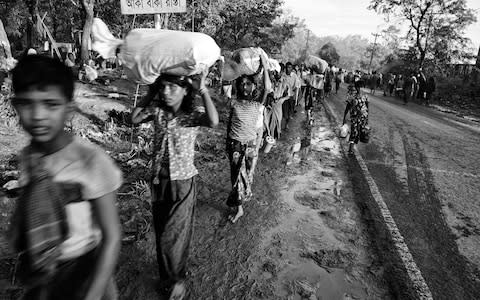
Hundreds of thousands of Rohingya have flooded into southern Bangladesh over the past month after violence erupted in the Burmese state of Rakhine. The north-south highway between the Bangladeshi cities of Teknaf and Cox’s Bazar is a steady flow of refugees.
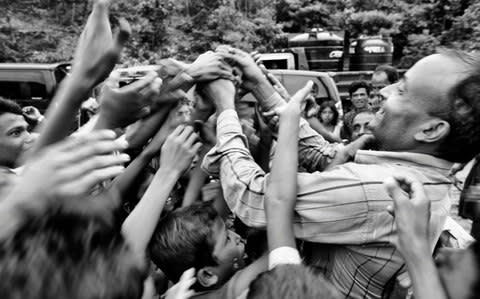
A middle-class Bangladeshi tosses small notes of currency into the air for young Rohingya children. At certain moments I get so incredibly frustrated with human beings. This was one of those situations. I couldn’t help but photograph it. He might have had the best intentions, but what he was doing was degrading. He wasn’t approaching these people as human beings. You see it happening a lot in the camps: well-intentioned people who aren’t thinking clearly about the way they go about things.
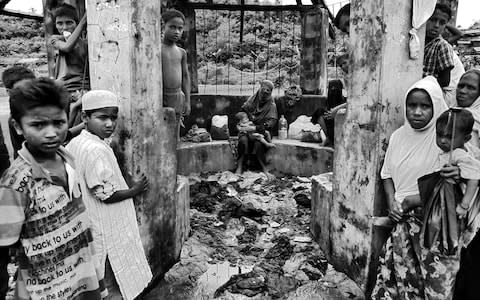
Rohingya women and children sit wherever they can find shelter along the road between Teknaf and Cox’s Bazar. They can be here for weeks before they are able to get a space on the back of a flatbed truck and move on to one of the refugee camps. The cramped journey takes about two hours, with only a tarpaulin for protection from the rain. The last time I made the journey with a group of them, it rained the whole way.
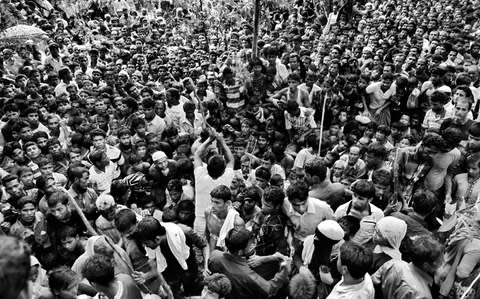
These days there are stations in the camps from which humanitarian assistance can be distributed. At any time of day, you see lines of people waiting to get to rice or some other food ration. There are also a lot of intrepid well-wishers, whether Bangladeshi or foreign donors, who drive in in big trucks. It causes these surges of complete mayhem – that’s what you see here. There are maybe 2,000 people swarming around the truck here, and the people distributing the food have to keep order by beating some of them back with sticks. It’s very inhumane in that sense.
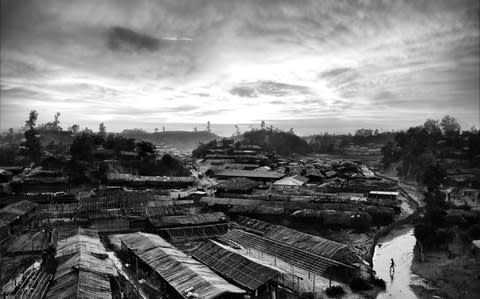
There’s a huge business in bamboo in the camps – it comes in on trucks almost daily, and this is what people use to build their homes. When I first visited, very little was organised, but things are much more coordinated now. Even when the huts are in the middle of being built, so just skeletons really, people still sleep under them. They have no protection from the elements. When you see the size of the camps, you think, “How many people are actually left in Burma when there are so many people here?”

